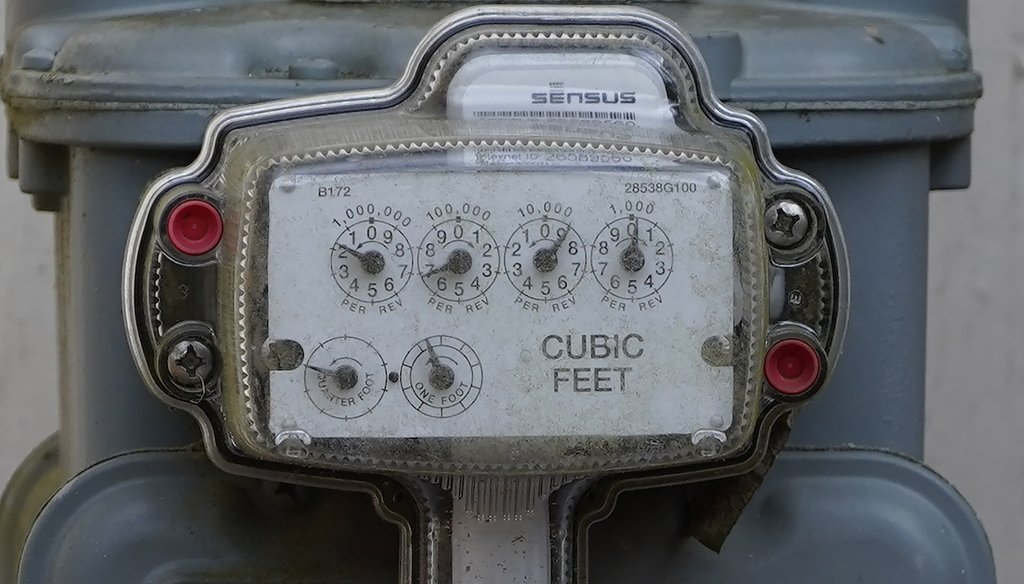Stand up for the facts!
Our only agenda is to publish the truth so you can be an informed participant in democracy.
We need your help.
I would like to contribute

A home gas meter in Jackson, Miss. The largest share of electricity in the U.S. is generated by natural gas. (AP)
If Your Time is short
-
A group backed by the natural gas industry is making this pitch: Natural gas is a reliable source of energy that’s cleaner than coal and can be “partnered” with renewables toward a “clean energy” future.
-
Experts say natural gas generally pollutes less than coal and will be needed as a reliable source for generating electricity until renewable energies are further developed. But natural gas is still a significant polluter.
"Clean energy" seems irresistible. Could you oppose energy that doesn’t pollute?
But the term’s imprecision leaves it open to interpretation — and sometimes manipulation.
Wind and solar are "clean," right?
But is natural gas clean — or at least less dirty?
Natural Allies for a Clean Energy Future, a group backed by the natural gas industry, is trying to sway public opinion, particularly among Democrats. The group doesn’t call natural gas "clean energy," but casts it as a companion.
The pitch, backed by prominent Democrats such as former Sen. Mary Landrieu of Louisiana and former Rep. Tim Ryan of Ohio, is that natural gas, as a reliable energy source with fewer carbon dioxide emissions than coal, can be "partnered" with renewable energy to "accelerate our path to a clean energy future."
The group, which has advertised since 2021, claimed in a January ad:
"Replacing coal with natural gas is the best way to cut emissions, reach climate goals and power our future reliably, cleanly and affordably."
Energy and climate experts said natural gas is reliable and generally pollutes less than coal. But, as a significant polluter, it is not the best way to cut carbon emissions, given that renewables such as wind and solar produce far fewer emissions.
"To say that natural gas is the best, I don’t think any natural gas company CEO testifying before Congress would say that," said Jay Hakes, former administrator of the U.S. Energy Information Administration under Democratic President Bill Clinton.
At the same time, experts said natural gas is still needed as development of renewables such as wind and solar continues. Unlike a coal plant, a natural gas operation can effectively be turned on and off, based on when renewable energy is available.
"It is an intermediate step" in reducing carbon emissions, said climate expert Gary Yohe, an economics and environmental studies professor at Wesleyan University. "It makes enormous sense in the next 10 or 15 or 20 years, but this is not certainly the solution."
Group doesn’t hide its backers, doesn’t advertise them
Natural Allies for a Clean Energy Future doesn’t reveal in ads that it is funded by the natural gas industry. Executive Director Susan Waller is a former energy company executive who worked at Enbridge and Spectra Energy. The Texas-based nonprofit formed in 2020 and raised $4.7 million in 2021, according to a tax return it filed in October.
Natural Allies does not disclose its funders directly on its website. The group’s news releases state that its backers include natural gas and natural gas pipeline companies — among them, the Williams Cos., National Fuel Gas, Enbridge and TC Energy.
TC Energy is the Canadian pipeline company that planned to build the Keystone XL pipeline, which would have spanned from Hardisty, Alberta, to Steele City, Nebraska. President Joe Biden revoked permitting for the project in 2021.
Promoting its efforts among Democratic voters, Natural Allies announced in January that it added Ryan, the former Democratic representative, to its leadership council. Ryan replaced one former Democratic senator, Heidi Heitkamp of North Dakota, and joined another, Landrieu.
Landrieu is a policy adviser for a law and government relations company in Washington that specializes in energy. She told PolitiFact that Natural Allies targets Democrats because they don’t get the "right information they need to make the right judgment about how to truly solve the climate problem."
"Natural gas is extremely effective in solving the problems we have," because it emits fewer pollutants than coal and is more abundant than renewables, she said. "It’s the most effective way currently and in the near future to reduce harmful emissions."
Natural gas is a reliable energy source
The U.S. Energy Information Administration doesn’t define clean energy; it defines renewable energy as energy from sources that replenish naturally. Major types include biomass (such as biomass and landfill gas), hydropower, geothermal, wind and solar.
As a fossil fuel, natural gas — which is composed of many compounds, largely methane — is not included.
Natural Allies has a point about how much Americans rely on natural gas. It is the leading source of electricity generation in the U.S.
The Energy Information Administration estimated that in 2023, the U.S. will generate 39% of its electricity from natural gas, 24% from renewables, 20% from nuclear and 17% from coal.
Natural pollutes less than coal, more than renewables
Experts said natural gas is generally considered a smaller polluter than coal, but emits far more carbon than renewables.
The Energy Information Administration estimates the amount of carbon dioxide produced by power plants per kilowatt hour of electricity generated.
The latest available figures, for 2021, show coal at 2.26 pounds of CO2 per kilowatt hour, petroleum at 2.44 and natural gas at 0.97.
Drilling, transportation and distribution of natural gas results in leakage of methane, a powerful greenhouse gas, said Susan Tierney, who specializes in the electric and gas industries at the Analysis Group consulting agency. That greatly reduces its emissions advantage relative to coal, she said.
Renewable energy, meanwhile, produces far less carbon dioxide, other greenhouse gases and pollutants than fossil fuels.
Going forward
Hakes urged the natural gas industry to be cautious in its claims.
"It’s useful for the gas industry to remember that there used to be ads running for clean coal," he said.
But even as solar and wind become more affordable, natural gas will remain vital, Hakes said.
"I take my scars with the environmental groups because I’m saying you can’t do away with natural gas, at least not in the next 20 or 30 years," he said, "and they get all mad at me."
Tierney said it is broadly held that reducing energy use by improving energy efficiency is the most economical way to reduce energy bills and cut carbon dioxide emissions, and that less coal for power generation is a near-term way to reduce emissions.
"There are complicated needs for the combination of energy resources that contribute to providing reliable, clean and affordable power," she said. "Diversity of supply is a key component of accomplishing that objective."
Our Sources
PolitiFact, "Joe Biden: Clean energy to provide 84% of new electric power this year," Jan. 29, 2021
PolitiFact, "Obama claims U.S. has doubled production of 'clean energy,’" Jan. 20, 2015
YouTube, Natural Allies for a Clean Energy Future "Our Future" ad, Jan. 20, 2023
Email, Chris Higginbotham, U.S. Energy Information Administration spokesperson, Feb. 21, 2023
LinkedIn, Susan Waller biography, accessed Feb. 21, 2023
U.S. Energy Information Administration, "Renewable energy explained," accessed Feb. 20, 2023
U.S. Energy Information Administration, "Short-Term Energy Outlook," Feb. 7, 2023
U.S. Energy Information Administration, "Electricity explained," July 15, 2022
U.S. Energy Information Administration, "How much carbon dioxide is produced per kilowatt hour of U.S. electricity generation?", Nov. 25, 2022
Natural Allies for a Clean Energy Future, "About us," accessed Feb. 20, 2023
Natural Allies for a Clean Energy Future, "Former Democratic U.S. Congressman Tim Ryan Joins Effort To Support Essential Role Of Natural Gas In Meeting Climate Goals Securely, Reliably And Affordably," Jan. 26, 2023
Washington Post, "The gas industry is under fire. It’s hiring Democratic politicians to help," Feb. 2, 2023
The Guardian, "How the gas industry aims to rebrand as ‘clean’ energy to appeal to Black and Latino voters," June 30, 2022
MIT, "Renewable Energy," Feb. 2, 2023
U.S. Energy Department Office of Energy Efficiency and Renewable Energy, "How Wind Energy Can Help Us Breathe Easier," Aug. 16, 2022
PR Newswire, "Former Democratic U.S. Sens. Landrieu and Heitkamp Join Effort to Support Essential Role of Natural Gas in America's Clean Energy Future," Jan. 26, 2022
Email, Susan Tierney, senior advisor in energy and environment, specializing in the electric and gas industries at the Analysis Group business consulting firm, Feb. 22, 2023
Interview, climate expert Gary Yohe, Huffington Foundation emeritus professor of economics and environmental studies, Wesleyan University, Feb. 22, 2023
Interview, Jay Hakes, former administrator of the U.S. Energy Information Administration, Feb. 22, 2023
Interview, former U.S. Sen. Mary Landrieu, Natural Allies for a Clean Energy Future leadership council member, Feb. 24, 2023
Email, Natural Allies for a Clean Energy Future spokesperson Emily D’Alberto, Feb. 24, 2023
IRS, Natural Allies for a Clean Energy Form 990 for 2021, Oct. 25, 2022


























